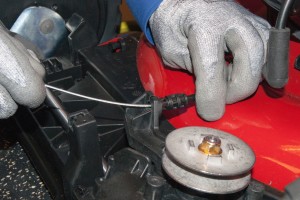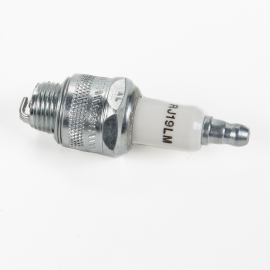- Kenmore refrigerator water filters
- Whirlpool refrigerator water filters
- Samsung refrigerator water filters
- GE refrigerator water filters
- LG refrigerator water filters
- Frigidaire refrigerator water filters
- KitchenAid refrigerator water filters
- Maytag refrigerator water filters
- Kenmore Elite refrigerator water filters
- Estate refrigerator water filters
- GE Profile refrigerator water filters
- Amana refrigerator water filters
- Bosch refrigerator water filters
- Dacor refrigerator water filters
- Electrolux refrigerator water filters
How to replace a lawn mower transmission

This DIY lawn mower repair guide gives step-by-step instructions for replacing a lawn mower transmission. The transmission rotates the axle to drive the mower wheels, moving the mower forward. Replace the transmission with a manufacturer-approved lawn mower part if the transmission is locked up or won't drive the wheels when engaged.
Follow this procedure to replace the front-wheel drive transmission on common Craftsman and MTD walk-behind lawn mowers.
A transmission problem is just one reason the wheels of a lawn mower won't drive forward. To learn how to diagnose a lawn mower drive problem, see Lawn Mower Won't Move Troubleshooting Video: Motion Drive Failure.
Quick links
Video
Instructions
Tools required
Nut driver set
Drill driver
Driver bit set
Locking pliers
Pliers
Socket wrench set
Wood block
bungee cords
Plastic bag
Work gloves
Repair difficulty
Time required
60 minutes or less
Repair difficulty
Time required
60 minutes or less
Replacing the transmission on a lawn mower
This video explains how to replace the transmission on a walk-behind lawn mower.
Instructions
- 01.
Disconnect the spark plug wire
Disconnect the spark plug wire from the spark plug.

PHOTO: Disconnect the spark plug.
- 02.
Remove the drive cover
Remove the fuel tank cap.
Place a plastic bag over the fuel tank opening and reinstall the fuel tank cap to prevent gasoline from leaking out through the fuel tank cap vent.
Tilt the mower back to lift the front wheels, then secure the mower handle to your work table to hold the mower steady as you remove the bottom-mounting screws.
Remove the drive cover’s bottom-mounting screws.
Release the mower handle from the work table and lower the mower to the upright position.
Remove the drive cover’s top-mounting screws.
Release the height adjuster lever and pull off the drive cover.

PHOTO: Remove the drive cover.
- 03.
Release the ground drive belt
Pull off the transmission belt keeper.
Roll the ground drive belt off the transmission pulley.
Keep tension on the drive belt while attaching one end of the bungee cord to the drive belt and the other end of the bungee cord to the rear discharge chute door lip to keep tension on the drive belt while replacing the transmission.

PHOTO: Release the drive belt from the transmission pulley.
- 04.
Release the drive control cable
Release the drive cable from the drive control lever.
Remove the drive cable end from the anchor post.
Depress the release tabs and pull the drive cable out of the transmission lever.

PHOTO: Release the drive cable from the anchor post.
- 05.
Remove the front wheels
Pry off the left front wheel hubcap.
While holding the front axle stationary, remove the wheel mounting nut.
Pull off the wheel and the dust cover.
Repeat the procedure to remove the right front wheel and dust cover.

PHOTO: Remove the front wheels.
- 06.
Remove the transmission
Attach locking pliers to the left side of the transmission axle to hold the axle stationary while you remove the left drive pinion gear.
While holding the transmission axle still, remove the screw that attaches the left pinion gear to the axle.
Remove the pinion gear and the transmission axle pin.
Repeat the procedure to remove the right side pinion gear and axle pin.
Remove the locking pliers from the transmission shaft.
Remove the transmission axle clip.
Pull the transmission up and disconnect the tension spring pin from the transmission.
Pull the transmission support bearings off the ends of the transmission axle.
Slide the transmission out of the wheel axle assembly.

PHOTO: Remove the pinion gear.
- 07.
Install the new transmission
Slide the new transmission into the wheel axle assembly.
Install the support bearings on the ends of the transmission axle.
Position the transmission above the front deck tray and connect the transmission to the tension spring pin.
Reinstall the transmission axle clip.
Reinstall the axle pin and pinion gear on the left side of the transmission axle.
Connect the locking pliers to the transmission axle to hold the axle stationary while you reinstall the pinion gear screw.
Reinstall the pinion gear screw and tighten it securely.
Repeat the procedure to reinstall the axle pin and pinion gear on the right side of the transmission axle.
Remove the locking pliers from the transmission shaft.

PHOTO: Install the new transmission.
- 08.
Reinstall the front wheels
Reinstall the left wheel dust cover.
Push the left wheel onto the axle and reinstall the wheel mounting nut.
Hold the front axle stationary and tighten the wheel mounting nut securely.
Reinstall the left front wheel hubcap.
Repeat the procedure to reinstall the right front wheel.

PHOTO: Reinstall the front wheels.
- 09.
Reconnect the drive cable
Push the drive cable into the transmission lever and engage the locking tabs.
Reconnect the drive cable end to the anchor post.
Reconnect the drive cable to the drive control lever on the lawn mower handle.

PHOTO: Reinstall the drive cable.
- 10.
Reinstall the drive belt and drive cover
Roll the drive belt onto the transmission pulley.
Reinstall the belt keeper.
Put the drive cover in position on the mower and re-engage the height adjuster lever.
Reinstall the drive cover’s top-mounting screws.
Tilt the mower back to lift the front wheels then secure the mower handle to your work table.
Reinstall the drive cover’s bottom-mounting screws.
Look through the opening in the debris shield to make sure the drive belt is still connected to the engine pulley. If the drive belt worked its way off the engine pulley during the repair, follow the steps in the repair guide for drive belt replacement to reconnect the drive belt to the engine pulley.
Release the mower handle from the work table and tilt the mower upright.
Remove the plastic bag from the fuel tank opening and reinstall the fuel tank cap.

PHOTO: Reinstall the drive belt.
- 11.
Reconnect the spark plug wire
Push the spark plug wire back onto the spark plug.
Warning: Undertaking repairs or maintenance to appliances or power equipment can be hazardous. Should you choose to undertake repairs or maintenance, you are assuming the risk of injury to your person or property. In an effort to reduce the risk, use the proper tools and safety equipment noted in the applicable guide and follow all instructions. Do not proceed until you are confident that you understand all of the steps and are capable of completing the repair. Some repairs or maintenance, however, should only be performed by a qualified technician.
Was this information helpful?
Symptoms for gas walk-behind mowers
Choose a symptom to see related walk-behind mower repairs.
Main causes: drive control cable failure, worn or broken drive belt, bad transmission, broken drive wheel…
Main causes: engine needs tune up, dirty or clogged carburetor, damaged flywheel key…
Main causes: dirty carburetor, bad spark plug, clogged air filter, engine choke problems, clogged gas cap vent…
Main causes: damaged cutting blade, loose cutting blade, damaged flywheel key, engine needs tune up…
Main causes: stale gas, engine needs tune up, bad spark plug, dead battery, bad recoil starter, faulty safety switch, ba…
Main causes: uneven wheel height settings, damaged wheel, dull or damaged cutting blade…
Repair guides for gas walk-behind mowers
These step-by-step repair guides will help you safely fix what’s broken on your walk-behind lawn mower.

How to replace a lawn mower spark plug
Take a few minutes to replace the spark plug during your lawn mower's annual tune-up or if the spark plug is burnt or cr…
Repair difficulty
Time required
15 minutes or less

How to replace a lawn mower drive cable
The drive cable engages the transmission to spin the drive wheels and move the mower across the grass. Replace the drive…
Repair difficulty
Time required
60 minutes or less

How to replace a lawn mower starter rope
These step-by-step instructions show how to replace a broken starter pull rope on a walk-behind lawn mower.…
Repair difficulty
Time required
30 minutes or less
Effective articles & videos to help repair your walk-behind mowers
Use the advice and tips in these articles and videos to get the most out of your walk-behind lawn mower.

Wondering when to mow your lawn for the best results? Timing matters more than you might think. Discover the best time o…

Learn about the top 10 must-have electric lawn & garden tools for 2023…

Learn about all the convenient features on our Sears PartsDirect website that make your parts purchases easier.…